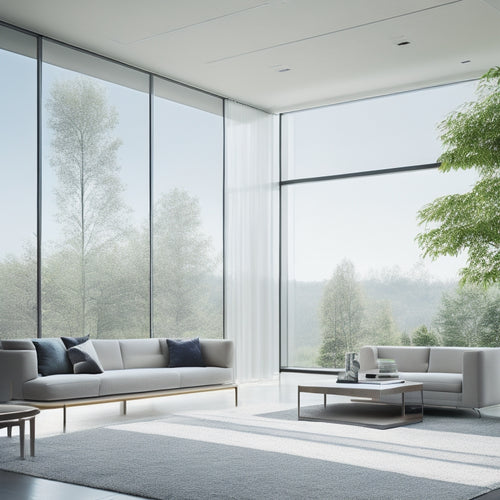
Why Choose Earth-Conscious Exteriors for Your Home?
Share
By choosing earth-conscious exteriors for your home, you're not only reducing your carbon footprint but also creating a healthier living space, enhancing your property's value, and contributing to a more sustainable future. Eco-friendly materials like reclaimed wood, bamboo, and low-VOC paints reduce environmental impact while maintaining aesthetic appeal. Plus, incorporating green roofing solutions and natural designs can increase energy efficiency, improve air quality, and even support local biodiversity. As you investigate the possibilities of earth-conscious exteriors, you'll uncover a world of sustainable solutions that not only benefit the planet but also uplift your home's unique character and charm.
Key Takeaways
- Earth-conscious exteriors reduce carbon footprint through sustainable materials, conserving resources and minimizing waste.
- Natural insulation techniques in earth-conscious designs improve energy efficiency, reducing energy costs and environmental impact.
- Incorporating plants and green installations in earth-conscious exteriors enhance air quality, supporting a healthier living environment.
- Earth-conscious features increase property value, making homes more attractive to eco-aware buyers and renters.
- By choosing earth-conscious exteriors, homeowners contribute to environmental conservation and biodiversity, promoting a sustainable future.
Sustainable Siding Options for Eco-Houses
Many eco-conscious homeowners invest in sustainable siding options to reduce their environmental footprint. You're likely reflecting on this too, and for good reason.
By adopting eco-friendly fleet solutions, such as renewable energy integration, we can reduce greenhouse gas emissions and operational costs.
Reclaimed wood and bamboo siding offer a natural, eco-friendly alternative to traditional materials. Fiber cement and composite materials provide durability without compromising on sustainability.
Straw bale and natural stone options are also gaining popularity for their unique aesthetic and eco-credentials. If you're looking for something more modern, corrugated metal siding can be a great choice.
Don't forget to contemplate a rain screen to improve thermal insulation and energy efficiency.
Eco-Friendly Exterior Paint Solutions
You're likely aware that traditional exterior paints can harm the environment and your health.
When choosing an eco-friendly exterior paint solution, you'll want to opt for ones made with natural ingredients that promote a healthier home and planet. By selecting low VOC options and a sustainable color palette, you'll be creating an exterior that not only looks great but also supports your values.
Additionally, adopting environmentally responsible practices, such as integrating renewable energy, can greatly reduce our carbon footprint and contribute to a cleaner future.
Natural Ingredients Matter
About 90% of exterior paint solutions on the market contain harsh chemicals that can harm the environment, but you don't have to contribute to this statistic.
Instead, you can opt for eco-friendly exterior paint solutions that prioritize natural ingredients. With the solar industry adopting closed-loop recycling and innovative technologies to minimize waste, it's crucial to make conscious choices in our daily lives as well.
Look for products featuring natural finishes, which not only reduce your carbon footprint but also provide a unique, organic aesthetic to your home's exterior.
Biodegradable coatings are another excellent option, as they're free from synthetic materials and can easily decompose without harming the environment.
Low VOC Options
As you investigate eco-friendly exterior paint solutions, another vital aspect to contemplate is the level of volatile organic compounds (VOCs) present in the paint.
VOCs can negatively impact indoor air quality and the environment. To reduce our carbon footprint, it's important to prioritize carbon footprint reduction and clean transport promotion, especially in rural areas Clean Transportation Infrastructure Grants.
-
Look for paints that meet stringent VOC regulations, such as those set by the Environmental Protection Agency (EPA).
-
Opt for water-based or plant-based paints, which typically have lower VOC levels than oil-based paints.
-
Consider paints labeled as "low-VOC" or "VOC-free," but be sure to check the ingredients and VOC levels to verify they align with your standards.
Sustainable Color Palette
When I imagine an eco-friendly exterior, I envision a harmonious blend of natural hues that not only complement the surroundings but also reflect my commitment to sustainability. You'll want to choose eco-friendly hues that blend seamlessly with nature. Consider the following sustainable finishes for your exterior:
| Eco-Friendly Hue | Inspired by Nature |
|---|---|
| Sage Green | Forest foliage |
| Sandy Beige | Desert dunes |
| Driftwood Grey | Weathered wood |
These sustainable color options not only reduce the environmental impact of your home's exterior but also create a visually stunning façade that harmonizes with the natural world. By selecting eco-friendly exterior paint solutions, you're making a conscious decision to prioritize the health of our planet while expressing your personal style.
Benefits of Recycled Building Materials
Embracing recycled building materials in your exterior design not only reduces your carbon footprint but also opens doors to a world of creative possibilities. By incorporating upcycled materials into your design, you're not only reducing waste but also giving new life to materials that would otherwise end up in landfills.
This approach to sustainable sourcing allows you to think outside the box and get creative with your exterior design. Additionally, it's crucial to take into account the role of renewable energy sources, such as solar-powered fast charging, in powering our homes and reducing our reliance on fossil fuels.
By making eco-friendly choices, we can minimize our impact on the environment.
- Reduces the demand for virgin materials, conserving natural resources
- Diverts waste from landfills, reducing greenhouse gas emissions
- Offers a unique opportunity for customization and self-expression, allowing you to put your personal stamp on your home's exterior
Low-Carbon Footprint Cladding Options
When selecting cladding for your home's exterior, you're not only choosing a material that protects your home from the elements, but also making a decision that impacts the environment.
By opting for eco-friendly material choices, you're reducing the carbon footprint of your home's construction and promoting a healthier planet.
Look for cladding options that prioritize sustainability and reduced carbon emissions to make a positive impact on the environment.
Eco-Friendly Material Choices
Your home's exterior cladding is more than just a protective layer - it's an opportunity to make a significant impact on the environment. By choosing eco-friendly materials, you're not only reducing your carbon footprint but also creating a healthier living space.
-
Consider bamboo siding, a highly renewable resource with natural resistance to pests and decay.
-
Reclaimed wood is another sustainable option, reducing waste and preserving the character of the original material.
-
Look for low-VOC (volatile organic compound) materials that promote better indoor air quality and reduce environmental toxins.
These eco-friendly material choices allow you to make a positive impact on the environment while creating a beautiful, unique exterior for your home.
Reduced Carbon Emissions
Beyond material selection, another essential aspect of an earth-conscious exterior is reducing carbon emissions, which can be achieved through low-carbon footprint cladding options.
You can greatly decrease your home's carbon footprint by choosing cladding materials that require less energy to produce, transport, and install. For instance, natural fiber composites, recycled aluminum, and low-carbon concrete are excellent alternatives to traditional materials.
These options not only reduce emission reduction during the production phase but also minimize waste and support a circular economy.
Green Roofing Materials for Homes
You're likely familiar with the concept of "going green," but did you know that it can extend to your roof as well?
Green roofing materials for homes are revolutionizing the way we think about exterior design. By incorporating eco-friendly options, you can reduce your carbon footprint and create a more sustainable living space.
Some popular green roofing materials include:
- Living roofs, which provide insulation and create habitats for wildlife
- Solar shingles, which generate electricity while protecting your home from the elements
- Recycled rubber roofing, which reduces waste and provides a durable, waterproof surface
Nature-Inspired Exterior Design Ideas
As the morning sun casts its rays on your exterior walls, consider the natural world's influence on your home's design. You can incorporate biophilic design elements to blur the lines between indoor and outdoor living. Nature-inspired exterior design ideas can change your outdoor space into a serene oasis.
| Design Element | Description | Benefits |
|---|---|---|
| Living Walls | Vertical gardens that bring greenery to your exterior walls | Air purification, insulation, and aesthetic appeal |
| Natural Materials | Using materials like reclaimed wood, stone, and bamboo | Sustainability, durability, and unique textures |
| Organic Shapes | Curved lines and irregular shapes inspired by nature | Softens the exterior's visual impact and creates visual interest |
Frequently Asked Questions
What Are the Cost Differences Between Eco-Friendly and Traditional Exterior Materials?
When comparing exterior materials, you'll find eco-friendly options often cost 10-20% more upfront, but their longer lifespan and lower maintenance needs can save you 30-50% in the long run, making them a worthwhile investment for your wallet and the planet.
Can I Still Achieve a Modern Look With Earth-Conscious Exterior Design?
You can absolutely achieve a modern look with earth-conscious exterior design, blending sustainable materials with modern aesthetics to create a unique, eco-friendly exterior that not only reduces your carbon footprint but also enhances your home's curb appeal.
How Do I Balance Sustainability With Durability in Exterior Materials?
In the Middle Ages, builders prioritized durability; now, you're tasked with balancing sustainability with durability in exterior materials. You'll find harmony by opting for sustainable materials that are also long-lasting options, like recycled metal and low-maintenance composite decking.
Are There Any Government Incentives for Eco-Friendly Exterior Renovations?
You'll find government incentives for eco-friendly exterior renovations, such as federal rebates and local programs, that can offset costs, giving you the freedom to choose sustainable materials that align with your values and benefit the environment.
Can I DIY Eco-Friendly Exterior Projects or Do I Need a Professional?
You're not a seasoned contractor, but you're handy - so, can you DIY eco-friendly exterior projects or do you need a professional? While some tasks, like installing rain barrels, are DIY-friendly, complex projects, like solar panel installation, demand professional knowledge for best results.
Related Posts
-

Why Choose Recycled Paper for Earth-Conscious Business?
By choosing recycled paper, you'll greatly reduce your business's environmental impact. You'll lower your carbon foot...
-

3 Sun-Powered Automated Shades for Energy-Savvy Homes
You're looking to change your home into an energy-savvy haven, and sun-powered automated shades are an essential step...
-

Why Biodegradable Dish Soap Matters for Earth-Conscious Homes
You likely don't realize that the dish soap you're using today will still be harming the environment long after you'v...


